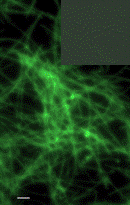Quorum sensing is a well characterized gene regulatory mechanism that coordinates diverse social behaviours in bacteria, such as biofilm formation, antibiotic resistance, etc.However, beyond bacteria this cell-to-cell communication mechanism is poorly understood.
The anaerobes research group led by Prof. DONG Xiuzhu in Institute of Microbiology,Chinese Academy of Sciences (IMCAS)has been engaging in the diversity and physiology of the anaerobic methanogenic Archaea, the only known organisms for production of CH4. Through a couple of years’ study, they find that Methanosaeta harundinacea 6Ac, a methanogenic archaeon dominated in the anaerobic reactor for treating waster water, displayed a cell mass-dependent morphology transition from short to filaments which was related to the AHL present in the spent culture. Further study determined that an active quorum sensing circuit filI/filR is used to regulate cell shape changing and even the carbon metabolic flux. filI gene encoded AHL synthase FilI, which catalyzes the bio-synthesis of a new class of carboxylated AHLs. These carboxylated AHLs are demonstrated to facilitate the transition of short cell to filamentous growth (Figure), and this kind of cell assembly favors the conversion of acetate to methane and a reduced yield in cellular biomass. The carboxylated AHLs are also detected in other methanogen cultures and putative filI orthologs are identified in other methanogenic genomes as well.
This work reveals that quorum sensing mechanisms are universal among prokaryotes and provides the potential applicable chemicals, the methanogenic AHLs, for improving sludge granulation so as to the degradation potentials. This is because that Methanosaeta species function as the crucial components of anaerobic digesters from their ability to form filaments that promote the formation of UASB granules by serving as a scaffold for attachment by other organisms. The result has been published on The ISEM Journal (http://www.nature.com/doifinder/10.1038/ismej.2011.203 )

Figure. Induction of filaments by carboxyl homoserine lactones of M. harundinacea.
Microscopic image of the filaments in conditioned medium with the spent culture of filamentous cells shows fluorescence at 420 nm, while the short cells (insert) exhibit no fluorescence. Bar, 5 µm. (Image by IMCAS)
